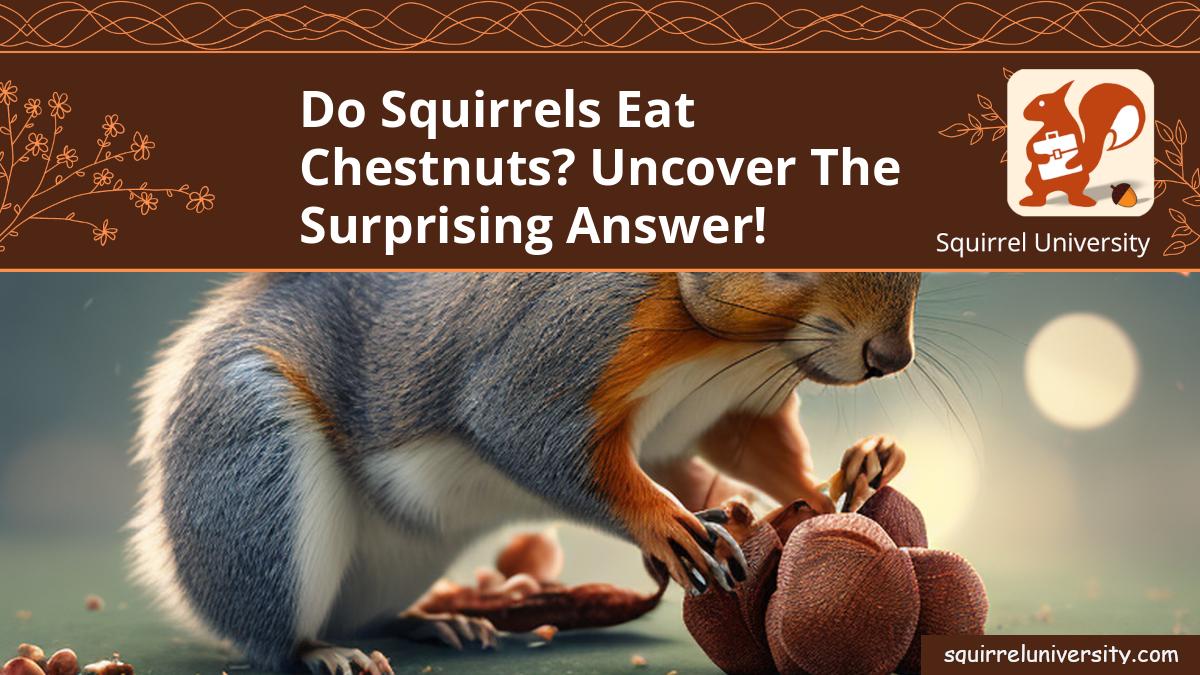As someone who has spent years observing and interacting with squirrels around the world, I can confidently say that yes, squirrels do eat chestnuts! In fact, this is one of their favorite snacks. But it may surprise you to learn that there’s more to the story than meets the eye. Join me as I uncover the surprising answer behind this age-old question: Do Squirrels Eat Chestnuts?
Yes, squirrels love to eat chestnuts! They usually go for the sweetest ones first and sometimes hoard them for later meals. Squirrels will also store some nuts underground as part of their winter food supply. Chestnuts provide squirrels with a nutritious and delicious snack that can be eaten all year long.
What Do Squirrels Eat?
It’s no secret that squirrels are able to enjoy a wide variety of food, but what exactly do they eat? They are omnivorous creatures, so the answer is quite extensive! From fruits and vegetables to nuts and seeds, these little critters feast on a range of items. In this blog post, we will be specifically exploring whether squirrels eat chestnuts.
Do Squirrels Eat Chestnuts?
Yes, squirrels do eat chestnuts! Studies have shown that gray squirrels are the primary carnivores in the UK and nuts, including chestnuts, make up a major part of their diet. They have unique teeth that enable them to crack tough nutshells like those of conkers, and they often store food for winter months such as chestnuts. However, eating horse chestnuts is potentially toxic for humans and animals – so it’s best to avoid feeding them to squirrels!
The Surprising Answer!
Yes, squirrels do eat chestnuts! While there are other items that squirrels prefer as part of their diet, chestnuts provide an important source of nutrition for these adorable critters. Research has shown that gray squirrels in the UK are the primary carnivores, with nuts (including chestnuts) comprising a major component of their diet.
When it comes to selecting which chestnuts to consume, research indicates that the weight of the nut is an indication of its quality. Therefore, more heavy chestnuts tend to be preferred over lighter ones. In addition, squirrels have evolved over time with unique teeth perfect for cracking tough shells like those found on conkers.
Chestnuts: A Nutritious and Delicious Snack for Squirrels
Squirrels love to eat chestnuts and this tasty snack offers them a wealth of nutritional benefits! Rich in protein, carbohydrates, vitamins and minerals, chestnuts are an excellent source of energy for these little critters. In addition to being delicious and packed with nutrition, chestnuts are easy to find and crack open – the perfect reward after a long day of foraging!
Nutritional Benefits of Chestnuts for Squirrels
Chestnuts can offer a number of nutritional benefits for your squirrel pals. As one research study has suggested, the weight of a chestnut is an indication of its quality when it comes to food preferences. The heavier the nut, the higher its calorie content – meaning it provides more energy which can ultimately help keep your squirrel healthy during those cold winter days.
Not only do chestnuts provide energy but also an abundance of vitamins such as C and B6 along with trace minerals like potassium and magnesium – all essential nutrients required by our friendly rodents. Additionally, these delicious tree nuts contain much less fat than regular walnuts or almonds making them easier on their digestive systems.
How to Tell If a Chestnut is Ready To Eat?
If you’ve ever seen a bunch of chestnuts at your local supermarket or farmers’ market then you’d know how difficult it can be sometimes just picking out the ones with edible tissue inside.
- Firstly, look for any signs indicating ripeness such as darkening skin color
- Next shake each not gently – if there’s no rattling sound then it’s likely ready
- Finally cut into one open-faced nut with either knife or scissors
If all these steps pass without any issue then congratulations! You now have yourself some fresh chestnuts fit for consumption by our little rodent friends.
Where Do Squirrels Find Chestnuts?
Squirrels have a special knack for finding chestnuts. This is because the nut tree is one of their favorite food sources. Squirrels are especially drawn chestnut trees, as they provide them with abundant food resources that can be used to store and save for the winter.
For squirrels, chestnuts represent an important component of their diet. They collect and consume nuts such as conkers, cobs and burs on a regular basis. Although chestnuts are not always in season, these animals know exactly when it’s time to begin stashing away food for the colder months. These omnivores also supplement their diets with other foods like fruits, vegetables and insects.
Tree Nuts: The Most Common Source of Chestnuts for Squirrels
Chestnut trees are one of the most common sources of nourishment for squirrels. Not only do they produce large amounts of nuts that contain high levels of energy-rich omega 3 fatty acids; they also offer shelter from harsh weather conditions or predators. Squirrels will take advantage of any opportunity to feast on tree nuts whenever they can find them.
During late summer and early autumn, mature chestnut trees start developing fruit that eventually ripens into edible nuts – a signal that autumn is just around the corner! At this time, many species of squirrel – including gray squirrels – begin harvesting these immature fruits before winter arrives. This way, they ensure that there’ll be enough food left over for their own needs throughout the cold season.
Squirrel Behavior When Eating Chestnuts
In order to survive the long winter months, it’s important for squirrels to store up food. That’s why they have developed some interesting habits when it comes to finding and eating chestnuts – or conkers, as they are sometimes called.
The most common source of chestnuts for squirrels is, naturally enough, tree nuts. In addition to the traditional ones found in an oak or chestnut tree, you might also spot them munching on conkers (horse-chestnuts) and even nibbling on burs from a birch tree.
Hoarding and Storing Nuts Underground
One fascinating behavior that squirrels use is caching. Once a delicious nut has been sourced from its natural environment – whether from an acorn or a cob – a squirrel will then construct something akin to a mini storage space underground.
- This hole is created with their front paws and knobby incisors, allowing them to bury their bounty ready for future meals during times of scarcity.
- You could liken this behavior to ‘hoarding’, only in this case they’re doing so with much tastier rewards in mind!
Gobbling Horse-Chestnuts with Ease
Unlike hard-shelled acorns which require cracking open with sharp teeth first, horse-chestnuts can be eaten whole by these cheeky critters!
Nibbling Burs for a Midday Snack
Birch trees often drop small pale brown fruits known as burs during late summer and autumn. As such they make an excellent snack while providing essential nutrients during harsh winters — look out for signs of gnawed or cracked husks beneath the branches!
Preparing for Winter by Stocking Up on Nuts
It could be argued that collecting nuts ranks very high among other creature comforts. Not only does store up on snacks provide nutrition throughout cold winter months; it also allows animals like gray squirrels ample opportunity for creative problem-solving — something we humans often take pleasure in too!
Nevertheless, gleaning from natural sources is fundamental knowledge shared across many species — constructing cozy holes underground isn’t exclusive either. It’s comforting to think that clever little rodents have managed wild abundance all around us since time immemorial.
Omnivore Diet: What Else Do Squirrels Eat?
Sure, chestnuts may be a major source of nutrition for squirrels, but they’re far from their only source. As omnivores, these furry critters are just as likely to enjoy the occasional greenery! In addition to tree nuts and seeds, squirrels can munch on plenty of crunchy fruits and vegetables as well. From juicy apples to crunchy carrots – or even sweet corn cobs – these animals have no shortage of snack options.
Squirrels don’t leave out insects either; during periods when nuts and berries are scarce, these creatures can easily turn to protein-rich insects like caterpillars or grasshoppers. With a wide variety of food types available, it’s clear that squirrel diets consist of much more than just chestnuts!
Fruits, Veggies, Insects, and More!
Squirrels may often be seen gathering and storing food for the colder months, like chestnuts, nuts, seeds and fruits. But did you know that many squirrels also feast on vegetables, insects, and even bird eggs? These diverse dietary habits mean that squirrels are actually omnivores – meaning they eat both plants and animals. Vegetables such as carrots, sweetcorn and lettuce are popular with some species of squirrels. They will also hunt for insects like grubs and caterpillars as well as eggs from smaller birds. So if you’re looking to attract these furry critters to your garden or park – make sure there’s something in it for them to munch on!
Squirrel Nutrition: The Best Food for a Balanced Diet
As with any diet, it’s essential that wild squirrels maintain a balanced and varied selection of foods in order to obtain proper nutrition. Nuts such as chestnuts provide them with healthy fats and proteins necessary for everyday activity; however, vegetation such as leafy greens also supply squirrels with vital vitamins and minerals needed for good health.
All in all, attaining an optimal diet involves finding the right balance between plant-based sources (fruits & veggies) and animal products (insect larvae). Trying out various combinations will ensure each animal receives complete nourishment from its particular environment throughout the year.
Conclusion
So, do squirrels eat chestnuts? The answer is yes! On occasion, squirrels have been known to find and scavenge for chestnuts if they cannot find other sources of food. While nuts are a primary source of nutrition for them, these clever creatures also understand that the protein-rich snack can be an important part of their diet.
Whether in the wild or your own backyard, you can now watch as these creatures munch away on their favorite treat — chestnuts. So go ahead, grab a bag of chestnuts and set some out this winter. You might just spot a few squirrels indulging in the delicious nutty snack.
You may also be interested in reading:

